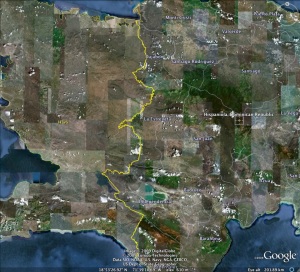“With any reforestation campaign, you have to find first a solution for energy.”
— Antonio Perera, Program Manager, UNEP, Haiti
The satellite image compares forest cover along the Haiti-Dominican Republic Border.
A recent New York Times article explains what happens when a country’s energy-poor population exhausts its last remaining fuelwood resources.
The country is Haiti and the picture painted is not pretty.
With much of its forest cover gone, the poorest (and oldest) developing country in the Western Hemisphere’s stands now on the brink of environmental catastrophe.
The story, reported by Nathaniel Gronewold of Greenwire, the web-based environmental policy and news service, describes a panorama that may resonate with a number of Sub-Saharan countries that are themselves today on the brink of environmental disasters. The problem in Haiti — and Uganda, Malawi, and Tanzania, to name a few — is driven by energy poverty.
“The country’s 10 million residents meet 60 percent of their commercial and residential energy needs with charcoal. It is used in most household cooking but also runs bakeries, laundries, sugar refineries and rum distilleries.
Charcoal production is a major factor in the deforestation that experts say has felled 98 percent of Haiti’s tree cover, with the remaining 2 percent disappearing fast. While mature trees provide the best material for charcoal production, the scarcity of wood has forced people to take smaller and smaller trees and shrubs. Today people are even pulling roots to make charcoal.
Haitians are aware of the damage being done to their landscape, but they say the deforestation for charcoal persists because there are few employment opportunities. About 80 percent of the population survives on less than $2 per day in income; the country ranks 149 out of 182 nations on the Human Development Index, a comparative measure of the quality of life.
But that drive to extract more and more from diminishing resources is only adding to the Haitians’ problems.”
Despite the gloom and doom, there is hope for Haiti, the story tells us, namely in the creation of small-scale, home-grown solutions designed to address energy poverty issues. The government and CHIBAS, a local environmental non-profit have high hopes for the bioenergy they hope to produce from a neo-tropical version of India’s jatropha plant. UNEP is also planning a massive, 20-year reforestation program. But, as the project manager says, “…with any reforestation campaign, you have to find first a solution for energy”.
The article glancingly mentions a briquettes program made from recycled urban waste paper. There is sadly nothing about energy efficient stoves or Amy Smith’s bagasse-based briquettes project. These constitute major omissions considering the array of substitute fuel and fuel-efficient projects that we know are underway on the ground.



Good post. (Your tweet button isn’t displaying the number of tweet correctly. When I used it, I found that there had already been 30, but the button on this page still says 0.)
Inger